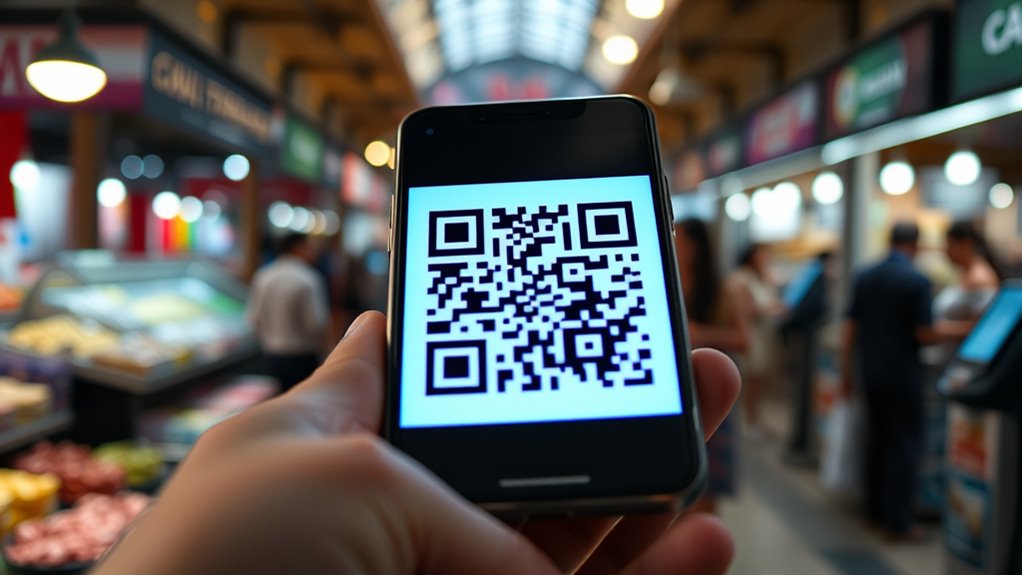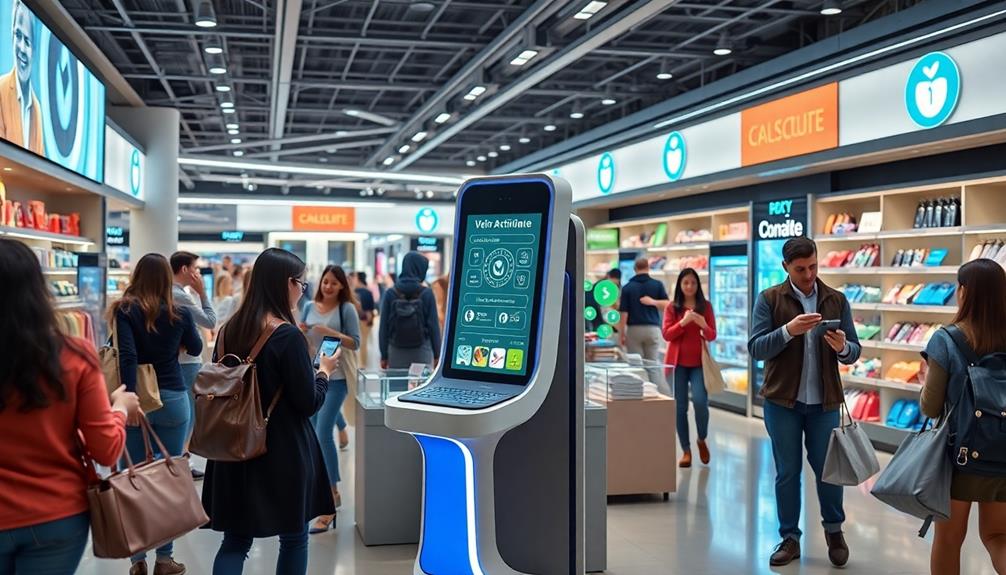QR code payments are rapidly gaining worldwide popularity due to their ease of use, security, and minimal infrastructure needs. Countries like China, India, and regions in Africa lead the adoption, helping shift toward cashless economies. Ongoing development of global standards by organizations like ISO guarantees these systems remain interoperable, secure, and user-friendly across borders. If you want to understand how these standards keep your transactions safe and seamless around the world, you’ll find plenty more to explore.
Key Takeaways
- QR code payments are widely adopted globally due to their simplicity and minimal infrastructure needs.
- Countries like China, India, and Africa are leading in QR code payment adoption, supporting cashless economies.
- Standardization efforts by ISO and industry groups promote secure, consistent QR code formats across regions.
- Interoperability standards enable cross-border transactions and seamless use across different platforms.
- Future developments focus on unified standards, enhanced security, and improved privacy to strengthen global adoption.

QR code payments have revolutionized the way you make transactions by simplifying the process to a quick scan. Instead of fumbling with cash or cards, you can now complete payments seamlessly using your smartphone. When you open your digital wallet, the QR code acts as a bridge between your device and the merchant’s point of sale, creating a smooth, contactless experience. Digital wallets store your payment information securely, making it easy to pay without exposing sensitive data. This convenience has driven widespread adoption across various industries and countries, transforming how businesses and consumers interact.
Security is a top concern when it comes to digital payments, and QR code systems have incorporated robust security protocols to protect your information. These protocols include encryption methods that safeguard the data transmitted during each transaction, ensuring that your payment details stay private. Additionally, many QR code payment platforms employ dynamic codes—codes that change with each transaction—making it nearly impossible for hackers to intercept and reuse them. These security measures, combined with multi-factor authentication in many digital wallets, help prevent fraud and unauthorized access. As a user, you benefit from these layers of protection, which work behind the scenes to keep your money and personal information safe.
The global adoption of QR code payments has been accelerated by their ease of use and minimal infrastructure requirements. Unlike traditional card systems that need costly point-of-sale terminals, QR codes can be generated and scanned using most smartphones. This makes them especially valuable in regions with limited banking infrastructure, where mobile and digital wallet adoption is growing rapidly. Countries like China, India, and parts of Africa have embraced QR code payments as a primary method of transaction, leading to a significant shift toward cashless economies. International standards for QR code formats and processing ensure compatibility across different platforms and countries, making cross-border transactions more straightforward. Moreover, the use of standardized headphone jacks in devices facilitates seamless connectivity for other accessories, enhancing the overall user experience.
As the technology continues to evolve, so do the standards that govern QR code payments. These standards aim to create a unified framework that promotes interoperability, security, and user privacy. Organizations like the International Organization for Standardization (ISO) and industry consortia work to develop guidelines that ensure consistent and secure implementation worldwide. This global effort helps you trust that the QR code payment systems you use are reliable, secure, and compatible with various digital wallets and financial institutions. Whether you’re paying at a local shop or abroad, these standards help facilitate smooth, secure transactions, reinforcing your confidence in this rapidly growing payment method.
Frequently Asked Questions
How Do QR Code Payment Standards Differ Across Countries?
You’ll notice that QR code payment standards differ across countries due to regional variations, which can create interoperability challenges. For example, some nations use specific encoding formats or unique data structures, making cross-border transactions tricky. These differences mean you may need different apps or scanners depending on where you are. To streamline your experience, governments and organizations are working toward harmonizing standards, but regional variations still impact global usability.
What Security Measures Protect Against QR Code Fraud?
You’re protected against QR code fraud through robust security measures like encryption protocols that safeguard your data during transactions. Authentication methods, such as two-factor authentication or biometric verification, guarantee only you can authorize payments. Keep your device’s security features enabled and avoid scanning codes from untrusted sources. These practices help prevent unauthorized access, making your QR code payments more secure and reducing the risk of fraud.
How Do QR Code Payments Impact Traditional Banking Systems?
QR code payments streamline your banking experience by integrating with digital wallets, making transactions quicker and more convenient. They reduce reliance on cash or cards, encouraging digital banking growth. As you adopt QR code payments, traditional banking systems evolve to support instant, contactless transactions, enhancing user convenience. Banks may also improve security measures, ensuring your funds are protected while you enjoy seamless, efficient payment options.
Are There Costs Associated With Implementing QR Code Payment Solutions?
Did you know that over 60% of retailers report costs when adopting QR code payments? Yes, there are costs associated with implementing these solutions, mainly regarding cost analysis and technology integration. You might need to invest in new hardware, software, or staff training. While initial expenses can seem high, the long-term benefits often outweigh the costs, making QR code payments a cost-effective choice for many businesses.
What Future Innovations Are Expected in QR Code Payment Technology?
You can expect future innovations in QR code payment technology to focus on enhancing security and convenience. Contactless transactions will become faster with the integration of biometric verification, allowing you to authorize payments seamlessly using fingerprint or facial recognition. Additionally, expect smarter QR codes that adapt to your preferences, enabling more personalized experiences. These advancements will make your transactions safer, quicker, and more intuitive, transforming how you pay daily.
Conclusion
As you navigate the world of QR code payments, it’s clear they’re transforming transactions into a seamless dance of convenience and security. With global standards paving the way, adoption will only accelerate, turning this technology into a universal language of commerce. Embrace the shift, because just like a well-choreographed routine, QR code payments are here to make your financial interactions smoother and more connected than ever before. The future of cashless transactions is within your reach.









